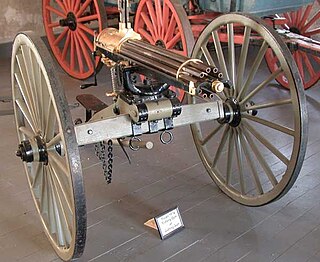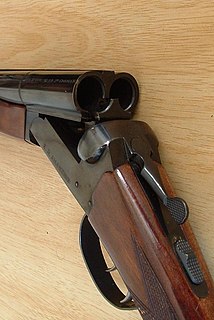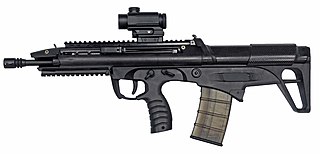
Gun safety is the study and practice of using, transporting, storing and disposing of firearms and ammunition, including the training of gun users, the design of weapons, and formal and informal regulation of gun production, distribution, and usage, for the purpose of avoiding unintentional injury, illness, or death. This includes mishaps like accidental discharge, negligent discharge, and firearm malfunctions, as well as secondary risks like hearing loss, lead poisoning from bullets, and pollution from other hazardous materials in propellants and cartridges. There were 47,000 unintentional firearm deaths worldwide in 2013.

The Gatling gun is a rapid-firing multiple-barrel firearm invented in 1861 by Richard Jordan Gatling. It is an early machine gun and a forerunner of the modern electric motor-driven rotary cannon.

A cartridge or a round is a type of pre-assembled firearm ammunition packaging a projectile, a propellant substance and an ignition device (primer) within a metallic, paper, or plastic case that is precisely made to fit within the barrel chamber of a breechloading gun, for the practical purpose of convenient transportation and handling during shooting. Although in popular usage the term "bullet" is often informally used to refer to a complete cartridge, it is correctly used only to refer to the projectile.

In firearms terminology, an action is the functional mechanism of a breech-loading firearm that handles the ammunition cartridges, or the method by which that mechanism works. Actions are technically not present on muzzleloaders, as all those are single-shot firearms with a closed off breech with the powder and projectile manually loaded from the muzzle. Instead, the muzzleloader ignition mechanism is referred to as the lock.

A gun barrel is a crucial part of gun-type ranged weapons such as small firearms, artillery pieces and air guns. It is the straight shooting tube, usually made of rigid high-strength metal, through which a contained rapid expansion of high-pressure gas(es) is used to propel a projectile out of the front end (muzzle) at a high velocity. The hollow interior of the barrel is called the bore, and the diameter of the bore is called its caliber, usually measured in inches or millimetres.
A pneumatic weapon is a weapon that fires a projectile by means of air pressure, similar in principle to the operation of pneumatic tube delivery systems. The term comes from a Greek word for "wind" or "breath" (πνεῦμα).
The overall length (OAL) of an ammunition cartridge is a measurement from the base of the brass shell casing to the tip of the bullet, seated into the brass casing. Cartridge overall length, or "COL", is important to safe functioning of reloads in firearms.

The Heckler & Koch HK CAWS is a prototype automatic shotgun—designed as a combat shotgun—co-produced by Heckler & Koch and Winchester/Olin during the 1980s. It was Heckler & Koch's entry into the U.S military's Close Assault Weapon System program.

In breechloading firearms, an extractor is an action component that serves to remove spent casings of previously fired cartridges from the chamber, in order to vacate the chamber for loading a fresh round of ammunition.

Calico Light Weapons Inc. (CLWS) is an American privately held manufacturing company based in Elgin, Oregon that designs, develops and manufactures semiautomatic firearms. It was established in 1982 in Bakersfield, California, and released its first production weapon in 1985. In 1998 its operations were moved to Sparks, Nevada, where replacement parts for existing weapons were produced.
FN BRG-15 was a heavy machine gun designed by Fabrique Nationale de Herstal as a potential replacement for the Browning M2HB .50 caliber machine gun.
The following are terms related to firearms and ammunition topics.

The 1931 Fabrique Nationale (FN) Baby Browning is a small blowback-operated semi-automatic pistol designed by Belgium-born Dieudonné Saive chambered in .25 ACP. The pistol features a six-round magazine capacity and is a striker-fired, single action, blow back mechanism. The manual thumb operated safety locks the slide in the closed position when engaged using side thumb pressure.
A firearm malfunction is the failure of a firearm to operate as intended for causes other than user error. Malfunctions range from temporary and relatively safe situations, such as a casing that did not eject, to potentially dangerous occurrences that may permanently damage the gun and cause injury or death. Improper handling of certain types of malfunctions can be very dangerous. Following gun safety rules can prevent firearm malfunctions, and limit the damage inflicted by them if they do occur. Proper cleaning and maintenance of a firearm play a big role in preventing malfunctions.

The Hi-Point Model CF-380 is a polymer-framed, semi-automatic, blowback-operated pistol manufactured by Hi-Point Firearms. It is chambered in .380 ACP.

The BR18 is a bullpup assault rifle made by ST Kinetics of Singapore.

Forensic firearm examination is the forensic process of examining the characteristics of firearms or bullets left behind at a crime scene. Specialists in this field are tasked with linking bullets to weapons and weapons to individuals. Obliterated serial numbers can be raised and recorded in an attempt to find the registered owner of the weapon. Nitric acid (HNO3) is the most common reagent used for this. Examiners can also look for fingerprints on the weapon and cartridges. Fingerprints are key pieces of evidence. If crime scene investigators find prints at a scene, they will be dusted, photographed, collected, and analyzed both by hand (using comparison microscopes) as well as compared to databases for potential references.

The Kel-Tec RDB is a bullpup carbine offered in 5.56×45mm NATO semi-automatic rifle, manufactured by Kel-Tec Industries of Florida. It uses a rotary bolt with a spring loaded ejector and an extractor facing down, ejecting spent shell casings downward, allowing easy ambidextrous use.

In breechloading firearms, primary extraction is the initial phase of the extraction of a spent casing from the firearm chamber. After the primary extraction comes the secondary extraction where the bolt is moved further backwards, and the extraction is then normally finished with the spent cartridge being ejected.















